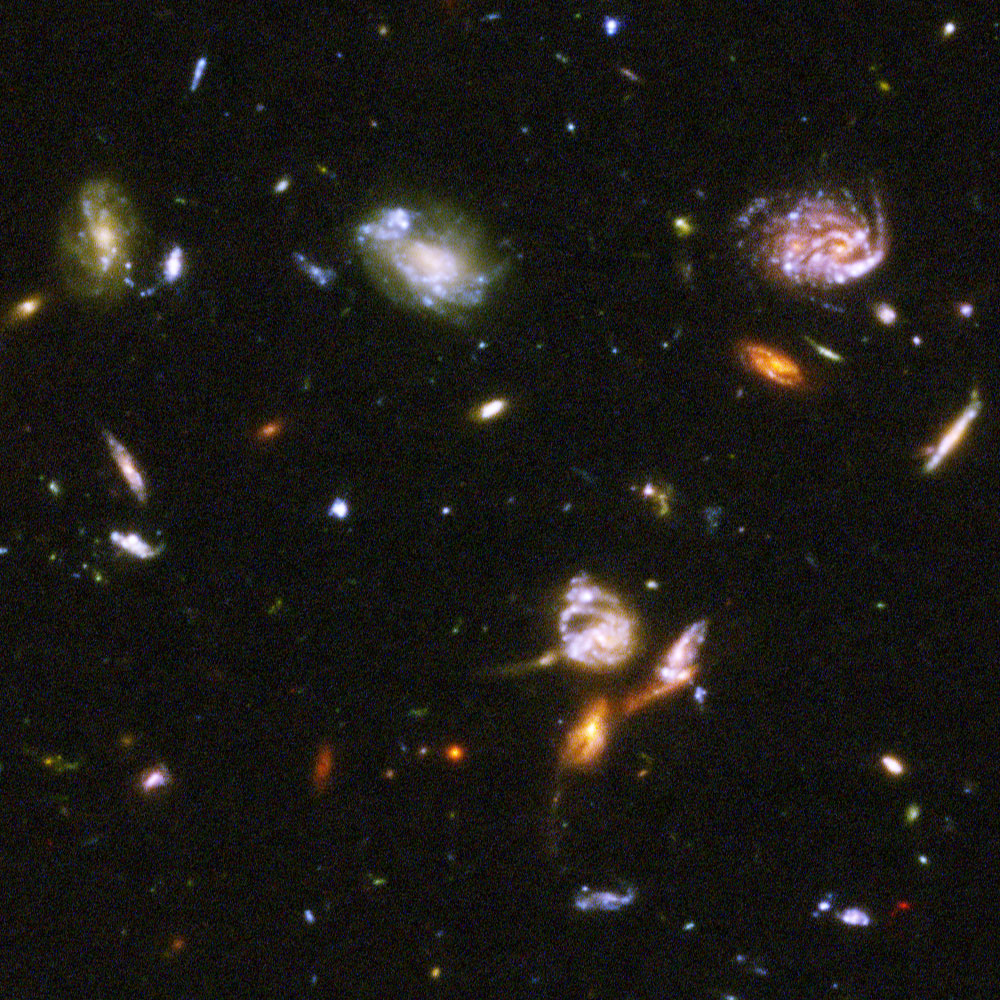
Caption: A zoom-in of upper middle-left of the Hubble Ultra-Deep Field (HUDF, 2003--2004).
Features:
- Many of galaxies seen in the
HUDF are at
cosmological redshift z ≥ 3
(corresponding to lookback time ∼ 8 Gyr)
and some may be at
z ≅ 12
(corresponding to lookback time ∼ 13 Gyr)
which is only about 0.6 Gyr after the Big Bang
(see
Wikipedia: Hubble Ultra-Deep Field: Contents).
- The cosmological physical distances
(i.e., distances at our instant in cosmic time)
are all ⪆ 10 Gly
(see cosmological distance measures graph).
But we see the galaxies as they were
at their respective
lookback times due to the
finite
vacuum light speed c = 2.99792458*10**8 m/s
(exactly) ≅ 3*10**8 m/s = 3*10**5 km/s ≅ 1 ft/ns.
Except, the light from them
has been
cosmological redshifted
due to the
expansion of the universe.
- In fact, for
cosmological redshift z
electromagnetic radiation (EMR)
has its
wavelengths increased by a factor of z+1.
Therefore, the EMR we are
seeing in the image has
its wavelengths increased by a factor of
≥ 4 since emission.
Now the
HUDF
is taken mainly in the
visible band (fiducial range 0.4--0.7 μm
= 4000--7000 Å), and so the
EMR we are
seeing in the image was emitted in the
ultraviolet band (fiducial range 0.01--0.4 μm).
In any case, yours truly thinks this a false-color image. Bright red and green galaxies in true color even when highly cosmologically redshifted do NOT exist yours truly thinks. Maybe yours truly is wrong. Maybe it's the Christmas version of the image.
- We see a good many
spiral galaxies in all orientations,
probably some smaller-in-apparent-size
elliptical galaxies
(which seem to appear mainly as orangy
ellipsoids),
and
at least one pair of interacting galaxies
as identified by the bar of stars
stretching between them.
Actually, it is clear that there is a huge range in distances to these galaxies. To explicate, spiral galaxies are NOT all the same size. Nevertheless, they tend to have an average size. So if you see two spiral galaxies in an image and one is about half the size of the other, it is probably about twice the distance. However, this rule of thumb may only apply in the modern/local observable universe. The spiral galaxies in the HUDF are cosmologically remote, and so long ago. Galaxies then had different behaviors than in the modern/local observable universe.
- Yours truly thinks there are NO foreground
stars at all in the image.
The field of view (FOV)
(angular size on the sky) is so small that
we are looking between all the stars.
What are foreground stars? Whenever you look to extragalactic space, you have to look past the stars in the Milky Way. So usually there is a swarm of foreground stars. Some of them are quite bright on the sky, and so show their diffraction pattern which manifests itself as points. Usually 4 points since the camera is held up by 4 equally-spaced arms: the diffraction pattern manifests this symmetry.
Local file: local link: hubble_ultra_deep_field.html.
File: Galaxies file: hubble_ultra_deep_field.html.